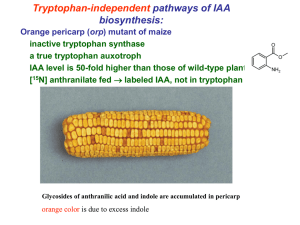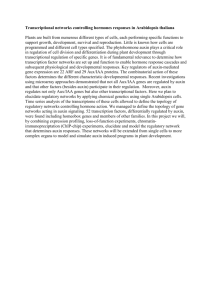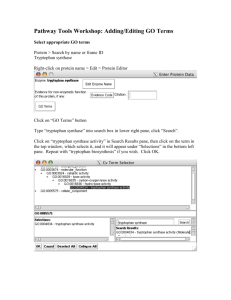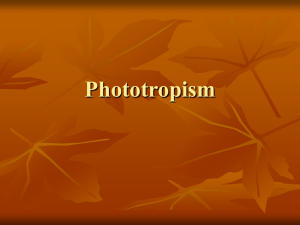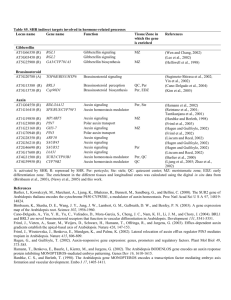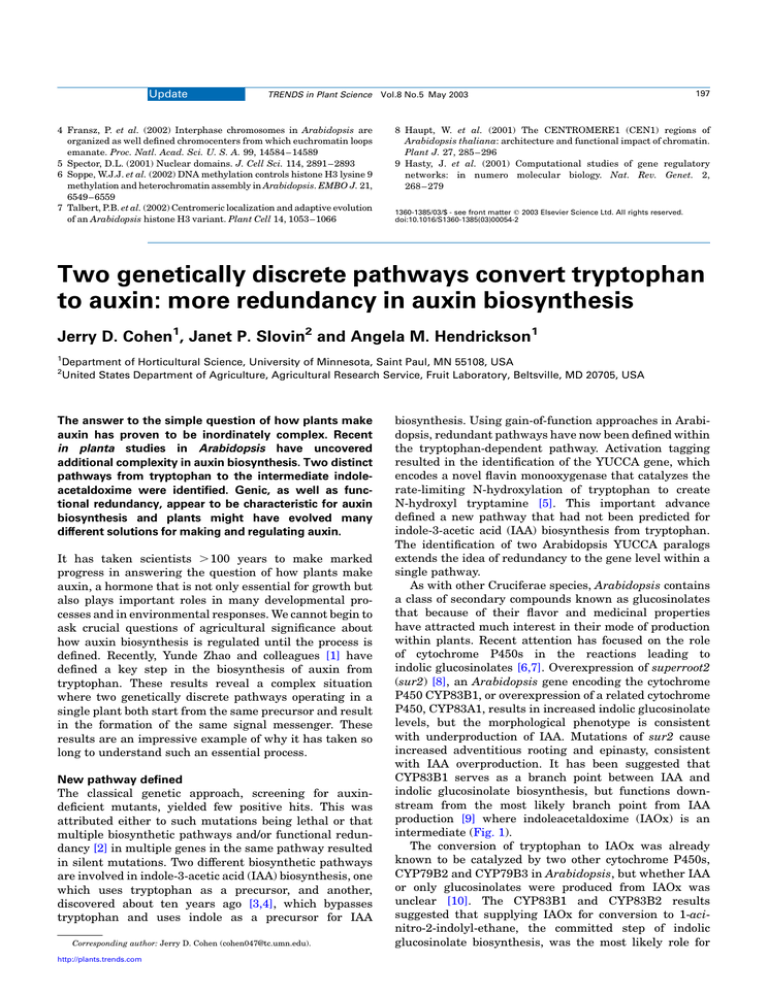
Update
TRENDS in Plant Science
4 Fransz, P. et al. (2002) Interphase chromosomes in Arabidopsis are
organized as well defined chromocenters from which euchromatin loops
emanate. Proc. Natl. Acad. Sci. U. S. A. 99, 14584 – 14589
5 Spector, D.L. (2001) Nuclear domains. J. Cell Sci. 114, 2891– 2893
6 Soppe, W.J.J. et al. (2002) DNA methylation controls histone H3 lysine 9
methylation and heterochromatin assembly in Arabidopsis. EMBO J. 21,
6549–6559
7 Talbert, P.B. et al. (2002) Centromeric localization and adaptive evolution
of an Arabidopsis histone H3 variant. Plant Cell 14, 1053–1066
Vol.8 No.5 May 2003
197
8 Haupt, W. et al. (2001) The CENTROMERE1 (CEN1) regions of
Arabidopsis thaliana: architecture and functional impact of chromatin.
Plant J. 27, 285– 296
9 Hasty, J. et al. (2001) Computational studies of gene regulatory
networks: in numero molecular biology. Nat. Rev. Genet. 2,
268 – 279
1360-1385/03/$ - see front matter q 2003 Elsevier Science Ltd. All rights reserved.
doi:10.1016/S1360-1385(03)00054-2
Two genetically discrete pathways convert tryptophan
to auxin: more redundancy in auxin biosynthesis
Jerry D. Cohen1, Janet P. Slovin2 and Angela M. Hendrickson1
1
2
Department of Horticultural Science, University of Minnesota, Saint Paul, MN 55108, USA
United States Department of Agriculture, Agricultural Research Service, Fruit Laboratory, Beltsville, MD 20705, USA
The answer to the simple question of how plants make
auxin has proven to be inordinately complex. Recent
in planta studies in Arabidopsis have uncovered
additional complexity in auxin biosynthesis. Two distinct
pathways from tryptophan to the intermediate indoleacetaldoxime were identified. Genic, as well as functional redundancy, appear to be characteristic for auxin
biosynthesis and plants might have evolved many
different solutions for making and regulating auxin.
It has taken scientists . 100 years to make marked
progress in answering the question of how plants make
auxin, a hormone that is not only essential for growth but
also plays important roles in many developmental processes and in environmental responses. We cannot begin to
ask crucial questions of agricultural significance about
how auxin biosynthesis is regulated until the process is
defined. Recently, Yunde Zhao and colleagues [1] have
defined a key step in the biosynthesis of auxin from
tryptophan. These results reveal a complex situation
where two genetically discrete pathways operating in a
single plant both start from the same precursor and result
in the formation of the same signal messenger. These
results are an impressive example of why it has taken so
long to understand such an essential process.
New pathway defined
The classical genetic approach, screening for auxindeficient mutants, yielded few positive hits. This was
attributed either to such mutations being lethal or that
multiple biosynthetic pathways and/or functional redundancy [2] in multiple genes in the same pathway resulted
in silent mutations. Two different biosynthetic pathways
are involved in indole-3-acetic acid (IAA) biosynthesis, one
which uses tryptophan as a precursor, and another,
discovered about ten years ago [3,4], which bypasses
tryptophan and uses indole as a precursor for IAA
Corresponding author: Jerry D. Cohen (cohen047@tc.umn.edu).
http://plants.trends.com
biosynthesis. Using gain-of-function approaches in Arabidopsis, redundant pathways have now been defined within
the tryptophan-dependent pathway. Activation tagging
resulted in the identification of the YUCCA gene, which
encodes a novel flavin monooxygenase that catalyzes the
rate-limiting N-hydroxylation of tryptophan to create
N-hydroxyl tryptamine [5]. This important advance
defined a new pathway that had not been predicted for
indole-3-acetic acid (IAA) biosynthesis from tryptophan.
The identification of two Arabidopsis YUCCA paralogs
extends the idea of redundancy to the gene level within a
single pathway.
As with other Cruciferae species, Arabidopsis contains
a class of secondary compounds known as glucosinolates
that because of their flavor and medicinal properties
have attracted much interest in their mode of production
within plants. Recent attention has focused on the role
of cytochrome P450s in the reactions leading to
indolic glucosinolates [6,7]. Overexpression of superroot2
(sur2) [8], an Arabidopsis gene encoding the cytochrome
P450 CYP83B1, or overexpression of a related cytochrome
P450, CYP83A1, results in increased indolic glucosinolate
levels, but the morphological phenotype is consistent
with underproduction of IAA. Mutations of sur2 cause
increased adventitious rooting and epinasty, consistent
with IAA overproduction. It has been suggested that
CYP83B1 serves as a branch point between IAA and
indolic glucosinolate biosynthesis, but functions downstream from the most likely branch point from IAA
production [9] where indoleacetaldoxime (IAOx) is an
intermediate (Fig. 1).
The conversion of tryptophan to IAOx was already
known to be catalyzed by two other cytochrome P450s,
CYP79B2 and CYP79B3 in Arabidopsis, but whether IAA
or only glucosinolates were produced from IAOx was
unclear [10]. The CYP83B1 and CYP83B2 results
suggested that supplying IAOx for conversion to 1-acinitro-2-indolyl-ethane, the committed step of indolic
glucosinolate biosynthesis, was the most likely role for
Update
198
TRENDS in Plant Science
Vol.8 No.5 May 2003
OH
CH
CH
CH2 O PO3
OH
NH
NH
Indole-3-glycerolphosphate
Indole
NH2
CH2 CH
CH2 CH2 NH2
NH
NH
Tryptophan
Tryptamine
NH
Indole
COOH
YUCCA
FLOOZY
CYP79B2
CYP79B3
CH2 CH
NOH
CH2 CH2 NHOH
Tryptophan independent
NH
NH
N-hydroxyl tryptamine
Indole-3-acetaldoxime
(IAOx)
O−
CH2 CH
O
CH2 C
NH
NH
Indole-3-acetaldehyde
Indole-3-acetonitrile
(IAN)
N
CH2 CH
CYP83B1
SUR2
N+
OH
NH
1-aci-Nitro-2-indolylethane
NIT1
NIT2
Indolic glucosinolates
CH2 COOH
NH
Indole-3-acetic acid
(Auxin, IAA)
TRENDS in Plant Science
Fig. 1. Summary of reactions involving CYP79B2, CYP79B3, YUCCA and CYP83B1 leading to the biosynthesis of indole-3-acetic acid (IAA). IAA biosynthesis independent of
tryptophan from free indole has been shown using tryptophan auxotrophic mutants of maize and Arabidopsis [3]. Biosynthesis from indole-3-pyruvate through indoleacetaldehyde to IAA is not shown, but is also thought to be active based on the presence of indole-3-pyruvate in Arabidopsis [18]. Abbreviations: NIT, nitrilase; SUR2,
SUPERROOT2.
these cytochrome P450s [7]. However, a detailed analysis
of CYP79B2 and CYP79B3 function relative to YUCCA
places these two proteins in the middle of another pathway
using IAOx in Arabidopsis for the production of IAA from
tryptophan [1].
A convergence of approaches produced these unexpected
results. Overexpression of CRY79B2 yielded plants with an
IAA-overproduction phenotype, elevated IAA levels and
increased expression of IAA-inducible genes similar to that
seen in yucca overexpressors, but different from that
obtained when IAA is supplied in the culture media. Both
CYP79B2 overexpression lines and yucca overexpressors
respond to tryptophan supplementation by increased
adventitious root formation and are resistant to toxic
analogs of tryptophan. Wild-type seedlings do not respond
http://plants.trends.com
to tryptophan supplementation. Consistent with the
concept of functional redundancy, single knockouts of
CYP79B2 or CYP79B3 had no profound phenotype.
However, double mutants displayed the shorter petioles
and smaller leaves associated with decreased auxin, as
well as a decrease in indoleacetonitrile (IAN) levels.
IAN is thought to be the next intermediate in this
pathway to IAA (Fig. 1). The story is further
complicated by the temperature dependence of the
effect on IAA levels in these mutants. IAA levels are
essentially the same as wild type at 21 8C but are
significantly reduced at 26 8C. Temperature has been
shown to affect the IAA biosynthetic pathway chosen by
other plant species [11] and a temperature effect on IAA
levels in Arabidopsis has been noted previously [12].
Update
TRENDS in Plant Science
Locations within the cell raise prospects
CYP79B2 and CYP83B1 are differentially localized
within the cell. CYP79B2 is chloroplastic and
CYP83B1 resides in the endoplasmic reticulum (ER).
YUCCA appears to be cytoplasmic. The disparate
localizations for these enzymes rule out their involvement in an IAA-synthase enzyme complex such as that
postulated by Axel Müller and Elmar Weiler based on
antibody pull-down studies [13], but do provide some
insight as to what the cell is doing with this
redundancy. The differential subcellular localizations
suggest that a great deal of internal indolic trafficking
is involved in the use and control of these pathways,
and is consistent with isotopic labeling studies that
showed that tryptophan-dependent and independent
IAA biosynthesis does not occur within the same
subcellular compartment [14]. Metabolic trafficking
seems to be a prerequisite if CYP79B2 and CPY83B1
are functioning together in the same pathway, but this
was not suggested by the labeling experiments.
Previous reports of KDEL-like ER retention sequences
on IAA-amino acid hydrolases [15] and on an auxin
binding protein, ABP1 [16], had been difficult to
understand, but as more data become available, the
cellular biology of auxin metabolism might become key
to our next level of understanding.
Different solutions for different plants
Several important conclusions are possible from the
CYP79B2 and CYP79B3 results, and these in turn
raise new questions. At least two routes for IAA
biosynthesis from tryptophan are active in Arabidopsis.
We can also conclude that multiple pathways arising
from different precursors, as well as functional redundancy within a single pathway, is characteristic of IAA
biosynthesis in Arabidopsis, although other plant
species appear to have evolved different solutions to
the problems of making IAA. FLOOZY, a YUCCA-like
flavin monooxygenase from petunia is, for example,
apparently a single-copy gene [17], and no orthologs of
CYP79B2 and CYP79B3 have been found in rice,
suggesting that there are different biosynthetic pathways in monocots.
We are now beginning to assign specific genes to a
function in the tryptophan-dependent IAA biosynthesis
pathway. This work allows us to predict what the
function of other genes in the pathway might be.
Although these are major advances, the enormity of
the problem of integrating this pathway with an
entirely different pathway that does not involve
tryptophan suggests that plant molecular geneticists
still have much more work to do. Strong biochemical
and genetic evidence for IAA biosynthesis from indole
or indole-3-glycerolphosphate independent of tryptophan needs to be followed up with gene discovery to
define the reactions involved in this process. Such
advances would then allow the relationship between
several pathways to be analyzed, which is necessary to
http://plants.trends.com
Vol.8 No.5 May 2003
199
understand the complexity in developmental and
environmental signaling processes that are transduced
through altered auxin levels.
Acknowledgements
Work in our laboratories on auxin metabolism has been supported by
grant DE-A102 – 94ER20153 from the US Department of Energy, by a
USDA National Needs fellowship to A.M.H., the Minnesota Agricultural Experiment Station, the Gordon and Margaret Bailey Endowment for Environmental Horticulture, and by funds from the US
Department of Agriculture Agricultural Research Service.
References
1 Zhao, Y. et al. (2002) Trp-dependent auxin biosynthesis in Arabidopsis:
involvement of cytochrome P450s CYP79B2 and CYP79B3. Genes Dev.
16, 3100 – 3112
2 Normanly, J. and Bartel, B. (1999) Redundancy as a way of life – IAA
metabolism. Curr. Opin. Plant Biol. 2, 207– 213
3 Ljung, K. et al. (2002) Biosynthesis, conjugation, catabolism and
homeostasis of indole-3-acetic acid in Arabidopsis thaliana. Plant Mol.
Biol. 50, 309– 332
4 Wright, A.D. et al. (1991) Indole-3-acetic acid biosynthesis in the
mutant maize orange pericarp, a tryptophan auxotroph. Science 254,
998 – 1000
5 Zhao, Y. et al. (2001) A role for flavin monooxygenase-like enzymes in
auxin biosynthesis. Science 291, 306 – 309
6 Bak, S. and Feyereisen, R. (2001) The involvement of two p450
enzymes, CYP83B1 and CYP83A1, in auxin homeostasis and
glucosinolate biosynthesis. Plant Physiol. 127, 108 – 118
7 Bak, S. et al. (2001) CYP83B1, a cytochrome P450 at the metabolic
branch point in auxin and indole glucosinolate biosynthesis in
Arabidopsis. Plant Cell 13, 101– 111
8 Barlier, I. et al. (2000) The SUR2 gene of Arabidopsis thaliana encodes
the cytochrome P450 CYP83B1, a modulator of auxin homeostasis.
Proc. Natl. Acad. Sci. U. S. A. 97, 14819 – 14824
9 Celenza, J.L. (2001) Metabolism of tyrosine and tryptophan – new
genes for old pathways. Curr. Opin. Plant Biol. 4, 234 – 240
10 Hull, A.K. et al. (2000) Arabidopsis cytochrome P450s that catalyze the
first step of tryptophan-dependent indole-3-acetic acid biosynthesis.
Proc. Natl. Acad. Sci. U. S. A. 97, 2379– 2384
11 Rapparini, F. et al. (2002) IAA metabolism in Lemna gibba undergoes
dynamic changes in response to growth temperature. Plant Physiol.
128, 1410– 1416
12 Gray, W.M. et al. (1998) High temperature promotes auxin-mediated
hypocotyl elongation in Arabidopsis. Proc. Natl. Acad. Sci. U. S. A. 95,
7197– 7202
13 Müller, A. and Weiler, E.W. (2000) IAA-synthase, an enzyme complex
from Arabidopsis thaliana catalyzing the formation of indole-3-acetic
acid from (S)-tryptophan. Biol. Chem. 381, 679 – 686
14 Rapparini, F. et al. (1999) Indole-3-acetic acid biosynthesis in Lemna
gibba studied using stable isotope labeled anthranilate and tryptophan. Plant Growth Regul. 27, 139 – 144
15 Davies, R.T. et al. (1999) IAR3 encodes an auxin conjugate hydrolase
from Arabidopsis. Plant Cell 11, 365 – 376
16 Napier, R.M. (2001) Models for auxin binding. J. Plant Growth Regul.
20, 244 – 254
17 Tobena-Santamaria, R. et al. (2002) FLOOZY of petunia is a flavin
mono-oxygenase-like protein required for the specification of leaf and
flower architecture. Genes Dev. 16, 753 – 763
18 Tam, Y.Y. and Normanly, J. (1998) Determination of indole-3pyruvic acid levels in Arabidopsis thaliana by gas chromatography-selected ion monitoring-mass spectrometry. J. Chromatogr.
A 800, 101 – 108
1360-1385/03/$ - see front matter q 2003 Elsevier Science Ltd. All rights reserved.
doi:10.1016/S1360-1385(03)00058-X

